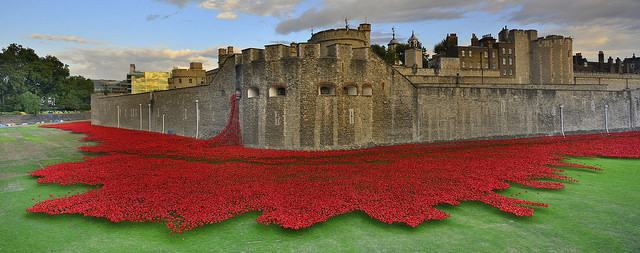The Poppies Bloom—One Hundred Years After the Great War
Tuesday, November 11th, 2014November 11, 2014
This Veteran’s Day (known as Remembrance Day in Canada, Australia, and New Zealand), in the centenary year of the start of World War I (July 28, 1914-November 11, 1918), at 11 am London time, the last ceramic poppy was placed in a moving art installation at the Tower of London. Blood Swept Lands and Seas of Red. The artist created a ceramic poppy for each British and Colonial military death during World War I. Since July, 888,246 poppies have been planted at the Tower, in a presentation meant to evoke blood pouring out of a Tower window and spilling over the land. With the placement of the last poppy, the installation will remain for 24 hours and then be taken down.

An art installation at the Tower of London, Blood Swept Lands and Seas of Red, by artist Paul Cummins, memorializes the British and Colonial dead of World War I. (Martin Pettitt)
The poppy came to represent World War I because of a poem written by a Canadian physician who served in World War I, John McCrae. His poem, “In Flanders Fields,” begins with perhaps the best known lines concerning World War I.
In Flanders fields the poppies blow
Between the crosses, row on row,
That mark our place; and in the sky
The larks, still bravely singing, fly
Scarce heard amid the guns below.
We are the Dead. Short days ago
We lived, felt dawn, saw sunset glow,
Loved and were loved, and now we lie
In Flanders fields.
Take up our quarrel with the foe:
To you from failing hands we throw
The torch; be yours to hold it high.
If ye break faith with us who die
We shall not sleep, though poppies grow
In Flanders fields.


